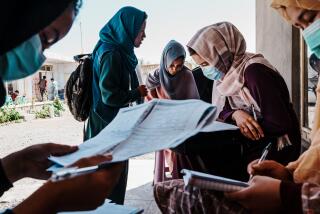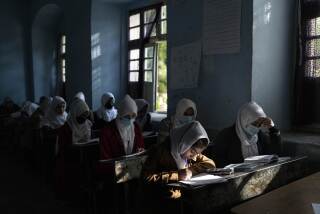China seeks to reeducate Tibetans on Dalai Lama
BEIJING — In an effort to quell unrest, Communist Party officials are ordering Tibetans back to school.
Buddhist monks, civil servants and public school students have been instructed to attend special classes in the virtues of Chinese rule and the evils of their exiled leader, the Dalai Lama. In these classes, the Tibetans read and recite from texts that denounce the Dalai Lama as a “political reactionary” and a “betrayer of the motherland.”
Ideological training is an enduring feature of Communist life, but has taken a back seat in a country consumed with more modern pursuits, such as making money. But in Tibetan areas, the Communist Party is pursuing “patriotic education” with new zeal.
But the campaign may be backfiring.
Clashes that erupted last week in Sichuan province’s Ganzi prefecture (known as Kardze to Tibetans) were reportedly triggered when the head of the Tongkor Monastery objected to Communist Party teaching materials that criticize the Dalai Lama. Tibetan activists say eight people were killed in the April 3 incident.
Nevertheless, Communist officials insist that the program be expanded.
Touring a monastery last week, the deputy Communist Party chief for Tibet, Hao Peng, called for strengthening “patriotic education so as to guide the masses of monks to continuously display the patriotic tradition.”
Besides the monks, Tibetan civil servants, party members and schoolchildren have attended special reeducation sessions, according to the Tibet Daily. At an elementary school, children viewed photographs of stores damaged in March 14 riots in Lhasa, the Tibetan capital, and sang patriotic songs.
“If I hadn’t seen it, I wouldn’t have believed those bad guys were so abhorrent,” the newspaper quoted a third-grader as saying.
In a Tibetan village, an elderly party member was reported to have shouted criticism of what officials call the “Dalai clique” during an education session: “They are going to plunge us once again into the abyss of suffering. Their methods are despicable and cruel.”
Tibet experts say the rhetoric harks back to the reeducation and self-criticism campaigns of the 1960s and 1970s, but is unlikely to be successful today.
“Getting people to denounce the Dalai Lama or to recite ideological statements shows a lack of imagination on the part of the Communist Party. There is no way they can force people into what they say is the correct way of thinking,” said Ronald Schwartz, a Canadian scholar.
Schwartz and more than 200 other Tibet experts have signed an online petition calling for the Chinese government to negotiate over Tibetans’ grievances, but he says he is not optimistic.
“Patriotic education” is one of the Tibetans’ major grievances against Chinese rule. The Communist Party intrudes into the minutiae of religious life, dictating which deities can be worshiped, what clothing can be worn, and the procedures for reincarnation -- a core belief in Tibetan Buddhism.
“Patriotic education is a euphemism for brainwashing,” said Chukora Tsering Agloe, a researcher at the Tibetan Center for Human Rights and Democracy.
Most provocative to Tibetans are the denunciations of the Dalai Lama. The 72-year-old monk and Nobel peace laureate is revered by Tibetan Buddhists as a deity; statements against him are considered blasphemous.
Monks who refuse to speak out against the Dalai Lama in patriotic education sessions are usually expelled from the monastery and sometimes are arrested. Last month, two monks were reported by Tibetan activists to have committed suicide because of the pressure.
Many of the recent demonstrations have been triggered by Chinese authorities’ attempts to confiscate banned photographs of the man Tibetans refer to simply as “his holiness.”
Teaching materials reveal the extent to which the Communist Party feels threatened by the Dalai Lama. Although the Dalai Lama has stated repeatedly that he favors more autonomy for Tibet rather than independence, teaching materials accuse him of being a pawn of “Western capitalists” who want to break up China.
“His aim is to cause chaos and split the motherland, to struggle in competition with us to control the minds of the people,” reads a pocket-sized pamphlet published in 1997.
Another text from 2002 describes the relationship between China and Tibet dating back to the 6th and 7th centuries when Tibetan kings were married to Tang dynasty princesses.
“It is clear that the Tibet region has had close relations with the motherland throughout its history,” it says.
The booklet (titled “Handbook for Education in Anti-Splittism”) goes on to describe how Chinese Communist rule lifted Tibetans out of feudalism and predicts a rosy future:
“The 1.3 billion children of China are striving without rest toward a renaissance of all China’s nationalities and one of the most glorious epochs in our 5,000-year history beckons.”
--
More to Read
Sign up for Essential California
The most important California stories and recommendations in your inbox every morning.
You may occasionally receive promotional content from the Los Angeles Times.










